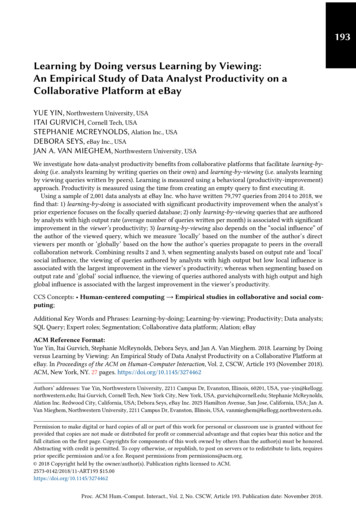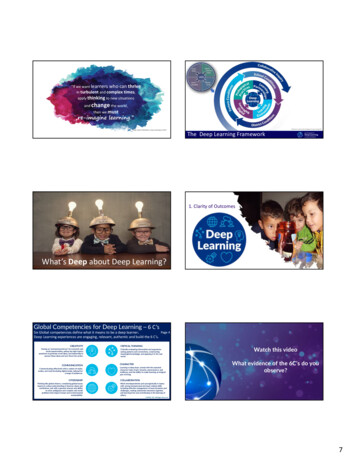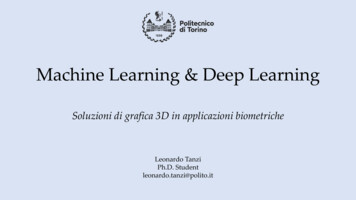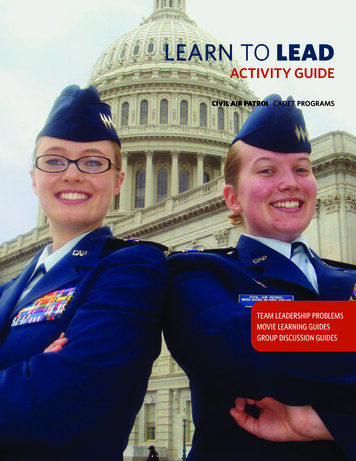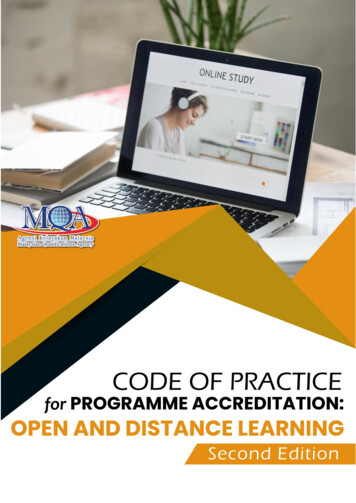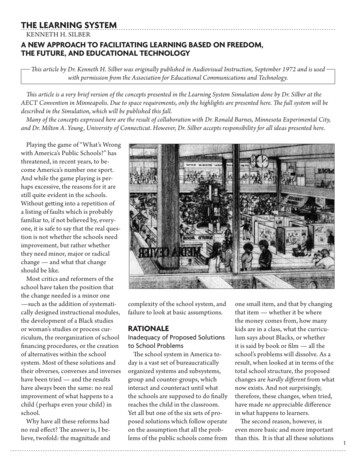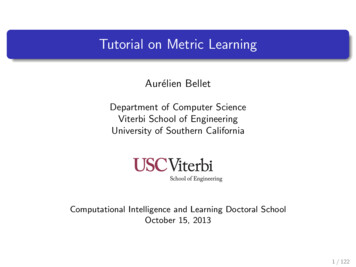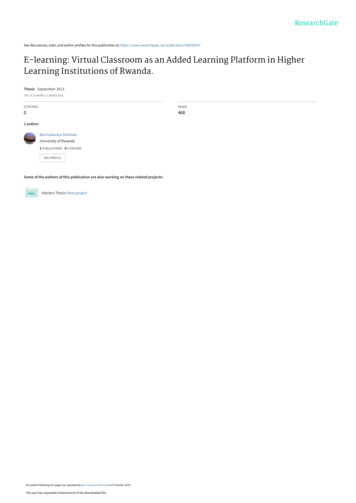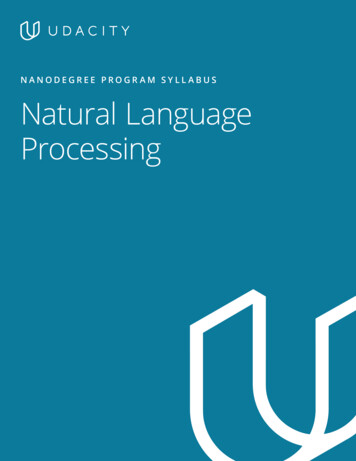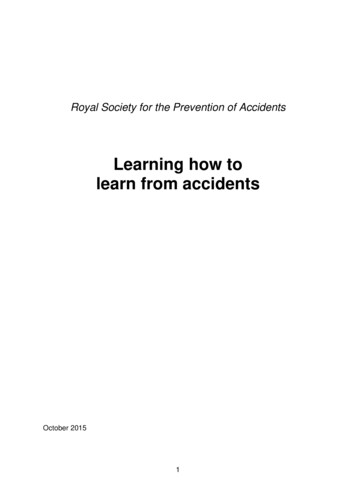
Transcription
Royal Society for the Prevention of AccidentsLearning how tolearn from accidentsOctober 20151
1) IntroductionThis resource has been developed by RoSPA to help you think about how well yourorganisation copes with accidents and incidents (unplanned, adverse events that canor do cause harm and/or loss) and its ability not just to stop them happening againbut to learn lessons that will help it improve its overall approach to managing forbetter health and safety outcomes.While it gives some guidance on what to do in the hours, days and weeks followingan accident, its main focus is on ‘operational readiness to investigate’ and onoptimising the conditions for good organisational learning, including from ‘nearmisses’ and dangerous occurrences. It is designed to support accident investigationtraining and further reading about the subject.2) ‘Windows on reality’Accidents are preventable but only if you understand how and why they happen.Understanding these things is only possible through good investigation. It is nocoincidence that businesses and sectors of the economy that have the best safetyrecords also have the strongest and most developed approaches to investigatingand learning from accidents.However well you manage risks, your organisation can expect to have someunplanned, unanticipated events. Accidents damage people and they damageorganisations - not just operationally as a result of business interruption andassociated costs but they cause damage to morale and also to corporate reputation.Yet accidents are also ‘windows on reality’ and thus present important opportunitiesfor organisations to learn lessons which, if acted on, will not only help preventrecurrence of the same kinds of events but will enable them to improve the way theymanage risks generally. In practice however there can often be real difficulties inidentifying and analysing the evidence, meaning that the ‘glass in the window’ can bedifficult to see through!Of course, when it comes to making things safer, we should all be trying to preventaccidents proactively using suitable and sufficient risk assessment (which in essenceis investigating before things go wrong). In reality however our ability to foresee andforestall accidents is always limited, so when they do occur, we need to understandthat they can actually be our one of our best teachers; although to be able tosqueeze safety learning out of them, we need to learn how to listen to what they tryare trying to tell us.In fact, learning how to learn from accidents and incidents - particularly byovercoming some of the common barriers such as fear, blame and anxieties aboutreputational loss and legal proceedings that arise in their aftermath - and developinga culture of reporting accidents, incidents, unsafe acts and conditions - is all part of amuch bigger culture change that is badly needed in so many of today’s businesses.The need to enhance the quality of learning from accidents remains one of RoSPA’skey occupational safety and health issues. The truth be told however, it has beenone of the hardest of all our policy priorities on which to make progress. Too manybusinesses seem to think they investigate accidents quite adequately.2
It is a sad fact however that most accidents and ‘near misses’ are still not reported,either within organisations or to relevant enforcing authorities (often due to fear ofconsequences) - and consequently there is no investigation of any kind. Although there are organisations that do have really effective approaches toinvestigation and organisational learning from accidents, many businesses often SMEs - still have no clear procedures for investigation (includingmanagerial and worker involvement). And even when there are procedures, there are still no effective criteria tohelp decide on the scale or the level of investigation to be adopted. In mostbusinesses this is still decided by the severity of resulting injury (often amatter of chance) rather than safety significance or learning potential of theevents that produced it. Often investigators fail to gather all the relevant facts. And distortions can creep into evidence gathering and analysis due touncritical biases. (We think we know what happened and thus we seek onlythat evidence which supports our suspicions. We stop our evidence searchwhen we think we have found ‘the cause’.) Little use is made of structured methods to integrate evidence. Many investigators tend to conclude the investigation too early and do not gofar enough, often failing to think outside conventional rules and operatingsystems or just focusing on the errors of individuals without searching for ‘rootcauses’ such as weaknesses in health and safety management systems. And even where investigations are of reasonable quality, there can still bepoor communication of ‘lessons learned’ and failure to track closure onresulting recommendations.These problems are not unique to health and safety. There is always the danger withinvestigations of all kinds that they can be quite cursory and superficial, leading torecommendations for narrow, technically focused ‘quick fixes’ rather than ‘root andbranch’ changes in risk management.RoSPA believes passionately that there is a need to demystify investigation andpromote ownership among managers and all other employees. But there is also aneed to build on what has been developed already in organisations, rather than try towork from a blank sheet.It is crucial that the habits of appropriate accident response are well established, ifnot ingrained, for example, through regular low level investigation of everydaysmaller scale incidents. This is not just about improving safety or health. After all,most organisations need to have robust processes in place for investigating otherkinds of mishaps and problems such as financial irregularities, quality issues,customer complaints and HR (Human Resources) issues.3
3) Coping in the aftermathStrong emotionsThe aftermath of an accident is never a comfort zone for anyone. People will havebeen injured or worse still, lost their lives; witnesses will have been traumatised;some people may feel threatened, for example, by the possibility of beingprosecuted, sued or disciplined. Often the desire uppermost in people’s minds is tofind an easy explanation for the accident, to clean up and move on. This is especiallytrue when only damage has occurred and luckily no one has been hurt - althougharguably ‘near misses’ are not just much more common than injury events but areusually much easier to learn from, precisely because there is less likely to be fear ofprosecution and civil claims.This sort of reaction is understandable. The strong emotions that arise in the wake ofan accident can be a barrier to investigation and learning - but equally they can alsobe an ally, in that for a period after the accident, everyone’s mind is focused onsafety and the need to improve it. So to fully exploit this opportunity it is vital toapproach accidents in a professional and systematic way; otherwise yourorganisation may not just be losing out when it comes to learning, you may also bestoring up trouble for the future. All organisations, even ones that seem to be ‘lowhazard’, need the right level of organisational and technical preparedness to copewith accidents and to move forward.ReadinessThe reason is simple. Unlike investors, customers, suppliers, clients or evenenforcement agencies, accidents do not phone ahead for an appointment. Thankfullyreally bad accidents with serious consequences do not happen that often but whenthey do, they happen suddenly and without warning and thus if you are a managerand if you do not have rehearsed ‘operational readiness’ to investigate (the rightpolicies, people, procedures, equipment etc in place), you will be left trying toimprovise, making up your response to events as you go along. When you find outlater that you should have acted differently, it will be too late.Understanding agendasFollowing an accident it is not unusual to find different parties all pursuing theirrespective agendas, often with the main focus on attributing fault and blame. This inturn tends to create an adversarial atmosphere that poisons relationships andprevents openness and learning. And even where the organisation does try to learnlessons, there can be some fairly fundamental errors such as a lack of clarity aboutpurposes or agreeing terms of reference with the commissioners of the investigation– usually senior managers who are accountable within the governance structure ofthe organisation. And at the end of the process there can be little (or worse still, no)communication of lessons learned and poor implementation of necessary safetychanges.LeadershipTo tackle these challenges accident investigation demands management leadership,not least because of the need to be able to be able to balance apparently conflicting4
agendas within the organisation such as controlling liability while maximising safetylearning, not to mention taking prompt remedial measures. And to enrich them andensure that their lessons are taken on board, investigations need meaningfulworkforce involvement too. As with tackling any key challenge in business, peopleneed to work together. You can only ‘do safety’ with people, not to them!Prioritisation and scalingDecisions are needed on how best to use limited investigation resources. Given theubiquity of the unplanned and the unexpected in the workplace, any organisationcommitted to learning from accidents (and in which these things are regularlyreported), would soon consume all their available resources if they investigatedthoroughly and to the same extent, all the hundreds of such events that beset them.So there is always a need to prioritise investigation effort and to scale response, notjust to respond to the seriousness or potential seriousness of outcomes but to exploitthe different levels of learning opportunity which accidents and incidents can present.Accidents resulting in fatal or life changing injuries or loss of control of a majorhazard - will obviously attract significant investigation effort. But sometimes amoderate consequence accident, which is of a type that is very frequent, may meritthe kind of in-depth investigation usually reserved for serious outcome accidentsbecause it seems to offer an excellent opportunity to unpick underlying contributoryfactors and thus provide a case study from which much useful safety learning can beextracted.Developing understandingNone of this is easy. It takes patience and commitment as well as time to perfectroutines and skills. It means being able, often under pressure, to balance competingconsiderations. It means managers, safety professionals and safety representativesand front-line workers developing a more sophisticated understanding of accidents,including understanding the complex interconnection of conditional factors thatsurround them. These include technology, systems, and human factors, especiallythe complex interplay of all the various forms of human error in this context(slips/lapses, mistakes – skill and/or rule based - and violations - whetherexceptional, routine or situational). Although on the surface accidents often seemsimple, once you start to assemble the evidence surrounding them and try tounderstand in detail how and why they occurred, you quickly realise how complexand intellectually challenging they can be.So above all there is a need for a vision of good investigation that enables everyoneinvolved to commit to a level of openness, as well as rigour, that will enable them touncover what has gone wrong - as well as how and why - and that will sustaininvestigation when the going gets tough – which it invariably does with accidents.4) Getting clarity about objectivesSenior manager involvementOne of the reasons that many senior managers have problems with investigation isthat they only tend to engage with them in a serious way when things have gonevery badly wrong and people have been seriously injured. Investigation of lessserious events is often left to people lower down the organisational hierarchy and5
even serious non-injury events – which are much more numerous – do not alwayslead to senior managers being involved in finding out what went wrong, how andwhy.So, given that serious accidents are rare, in organisations where the duty toinvestigate is delegated, the average interval between senior managers beinginvolved in an accident investigation can be very long indeed and consequently thehabits of investigation are not always well ingrained at this level. Too often, whenmanagers are tasked with taking charge of an investigation, it is only after they havestarted to respond to events that they realise that they have entered a minefield, notleast because it dawns on them that they are faced with having to deal with theneeds of a number of quite different parties, each of which is likely to have a slightlydifferent agenda.How best can the senior manager be helped to be aware of this at the outset so theydo not freeze like a rabbit in the proverbial headlights when the competing demandsof different people and organisations start to emerge in the days following anaccident?Reconciling needsThe first point to get across perhaps is that there is rarely a perfect solution.Reconciling all the different needs of parties such as insurers, HR departments,lawyers, unions, production managers and so on - is never easy. It’s often a bitmessy and involves managers in overall charge doing the best they can in thecircumstances. So if they find themselves confused in the early hours of a postaccident situation, whatever the immediate pressures, it is probably worth theirtaking some time out at the very start of the process, perhaps in discussion withcolleagues, to decide exactly what they are going to do to pick the right path for themand their organisation through this maze.Where to start?The most important thing is that, immediately following an accident emergencyprocedures should enable victims to receive prompt and effective help. Next, peopleand procedures should be in place so that the accident scene is made safe. But asfar as possible, it should be secured and left undisturbed. Reconciling these twoobjectives is not always so easy but it is the kind of issue that ought to be covered indebriefing on emergency preparedness rehearsals, such as unannounced fire andaccident drills etc.FamiliesThe next most important thing is that families and loved ones should be informedand steps should be taken to provide them with help and support. So managersneed to be sure that they can quickly establish contact with them but they also needto remember that these people, who need help in the hours following a seriousevent, may well be seeking legal redress later on. And they may also be witnesses inany subsequent prosecution and so on. Supporting victims’ families needs particularskills and sensitivity.Witnesses6
Like victims, witnesses to accidents are also likely to need help, particularly if theyhave been traumatised by violent events. But again it needs to be remembered that,whether they realise it or not, reflecting on and talking about their experiences withothers is likely to adversely affect the accuracy of their recollections. It is widelyacknowledged in many fields of safety that taking early witness statements can helpto minimise the decay and distortion that that inevitably occur in our memory ofevents due to the passage of time and the sharing of experiences with others. This isnot so much a consequence of deliberate selectivity or collusion on the part ofwitnesses but just the way memory and recounting history tend to work. But in thefirst hours after an accident, is close questioning of someone who has just witnesseda terrible event the most humane approach? Again skill and sensitivity are neededhere.Other colleaguesOther management colleagues will need to be involved, not just because they wantto be ‘kept in the loop’ so they can take early action to prevent a recurrence butbecause they may want to spot areas where they could have done more or wherethey may feel vulnerable. They may want to contribute but equally they may want tocover their tracks. They need reassurance that, while everyone is accountable fortheir actions, the organisation’s prime objective is to gather facts not to apportionblame.Front line workers and their representativesFront line workers themselves (and their union representatives if they have them) willwant to be kept informed as well. They will want reassurance that they are beinggiven the full facts and that action is being taken to make things safe and to learnlessons. But equally they may have their own views on the significance of theaccident and its implications. Union appointed safety representatives have statutoryrights to investigate and thus may also be gathering information. They may be calledon to act as witnesses. And they may also be thinking about what they might do tohelp injured members to claim damages later down the line. They need reassurancethat the processes of investigation and decisions about any subsequent action suchas disciplinary action or defending against claims for damages will be effectivelyseparated from one another.InsurersInsurers will want early notification of any serious accident or incident. This willprobably be a condition of any policy and there will be established mechanisms fordoing this. But it needs to be remembered that the insurer’s agenda includesretaining their ability to defend themselves against any future claim. While in generalthey will support the efforts that managers make to improve health and safety, whenthings have gone badly wrong and they may well be faced with having to settle alarge claim, they will not want the client to admit liability or make things too easy forthe claimant’s lawyers.RegulatorsThen there are the regulators such as the Health and Safety Executive (HSE) orlocal authorities. Of course, they will need to be informed immediately if the accidentinvolves a death, a serious injury, a significant injury to a member of the public or anotifiable dangerous occurrence. If the injury leads to more than seven days7
absence from work, then a report has to be made to the enforcing authorities. Andinternal records have to be kept of all these events of course as well as of notifiableill health conditions and of injuries leading to more than three days absence fromwork.While they investigate nearly all fatal injuries at work, HSE inspectors investigateonly a proportion of major injury events and much smaller proportion of the ‘overseven day’ injuries. Nevertheless the report goes on the organisation’s record asdoes any enforcement action taken in the wake of an accident and this is alsopublically accessible via the HSE website.In deciding what to do following an accident, HSE are guided by their EnforcementPolicy Statement that helps them determine what sort of enforcement, if any, wouldbe appropriate, including prosecution. Often they are keen to help managers. Whenaccidents are novel or where they may have strong learning points for others, theymay issue alerts to other businesses in the same sector etc. But equally they canquickly become adversaries, for example, if they decide to prosecute. HSE nowcharge for their investigation time via what is called ‘Fee-for-Intervention’. How muchmanagers seek to involve HSE in internal investigations often depends on suchconsiderations. (See also Section 7 below.)LawyersThe organisation’s lawyers too will want early notification of serious accidents andincidents, particularly ones that have been notified to the regulator. Most responsiblelawyers will take the view that accidents need to be investigated promptly andproperly, not just to try to avoid a repetition but from a claims perspective, to helpclients to settle any cases where they are liable and to contest them when they arenot. Others however may be keen to ensure that managers do not ‘ease the glidepath’ for the plaintiff or the prosecutor. They may see their brief as the defence oftheir client’s best interests. Consequently they may caution them against adopting anopen, team based approach to investigation, even though this may be the bestcourse if managers are trying to maximise involvement and buy-in from theworkforce. And they may suggest clients seek what is called ‘legal privilege’ so thatthey do not have to reveal certain details of their own internal investigation to HSE orother authorities that may be prosecuting. They will also want to ensure that any oftheir client’s employees who are interviewed by HSE ‘under caution’ are fully briefedand supported. Important as they are to assist the organisation, it is vital formanagers in overall charge of the investigation process, to ensure that their lawyers,like other experts, are ‘on tap but never on top’.Other business partnersThere are also many business partner organisations to be kept informed as well:clients will want to be informed and may choose to take a hand in the investigationprocess; fellow contractors, for example, will want to be kept abreast ofdevelopments; investors may require to be notified; equipment suppliers may needto involved; safety, trade and professional bodies also perhaps.Facts, fairness and opennessThose organisations that espouse a ‘no blame policy’ internally on the grounds thatthey are more anxious to learn than to punish, may seem to be putting prevention8
clearly at the top of their priorities but it is actually quite a hard doctrine to live up toin practice and some argue that it militates (to some extent at least) against the ideaof personal or group responsibility. When eventually the results of investigation areconfirmed, discipline, if not punishment, may need to be reserved as a last resort forsome people, for example, when it is clear that previous counselling and retraininghave failed. But if you end up disciplining people arbitrarily following an accident,having said that there would be no unfair recriminations, then you will lose credibilityand colleagues may not be so open in future. A ‘just culture’, based on facts andfairness, is likely to be more realistic but it is also hard to engender.The mediaOften managers may find that they are having to provide reports to the media andeven to local political representatives such as MPs and councillors. Accidents,particularly if they are badly reported, can pose a major threat to corporatereputation. Being open and transparent may help to avoid accusations of ‘cover up’later on but equally this can lead to information being used selectively and in waysthat are damaging to the organisation’s profile. The organisation’s communicationsteam also need to be brought fully into the picture from the very beginning.Organisations often feel that they are forced to choose between a policy of ‘telling itall and telling it early’ or being quite selective in the information they release.Increasingly higher performing organisations, including those that succeed in theRoSPA Occupational Safety and Health Awards - seem to be favouring openness.Their reasons include: the facts will always come out in the end; any attempt to limit information (or worse still to dissemble) is likely to besensed and cause critics to probe further; and a spirit of contrition and willingness to learn and improve may help tomoderate the final judgment of the courts and the public alike.Yet this path is not without its risks. Inevitably it will upset some colleagues. It mightsuggest, for example, that, if the organisation was so willing and able to learn afterthe event, it could have done so before (particularly if there had been precursorevents). When it comes to tightening safety in the immediate aftermath of a seriousaccident, some advisers may feel bound to give excessively risk averse advice forPR rather than safety reasons and so on. So if one thing is clear in all this it is thatwhile openness in the wake of accidents is the best policy, it is actually extremelychallenging and demands clear sightedness and really good communications.Remember the senior manager tooAnd finally there is a need to consider the needs of the senior manager in overallcharge of the investigation process. When all the post event processes are over (andthis can be several years if prosecution is involved), they have to be able to feel thatthey have done the best they could, both for their organisation and for themselves.After all, besides defending their own professional reputation, they have to be able tolook at themselves in the proverbial mirror and feel that they have acted withintegrity.9
In practice it is not realistic for any one individual to have to bear the burden ofbalancing all these complex considerations, especially when the actual business ofdealing with the aftermath of an accident can be distressing enough in itself. Unlessthey are unusually lacking in emotion intelligence, those who have had to informrelatives of the loss of a loved one, attend an inquest or be questioned by enforcingauthorities under caution, will bear the resulting mental scars to some degree for therest of their lives (although in the future these may actually serve to strengthen theirconviction that safety is important and needs to be properly managed). So it is theresponsibility of the organisation itself to lay down good guidance on how itsmanagers should act and be supported, particularly following serious accidents andincidents.In summary responding successfully to accidents demands of senior managers,wisdom, courage and above all leadership – not things that you buy off the shelf.5) Thinking harder about accidentsAvoiding over-simplificationThere are two very common errors in the way many people perceive accidents.Either they see them, at one extreme, as rare, chance events and combinations ofcircumstances which are beyond both prediction and control or, at the other end ofthe spectrum, they see them as quite simple events with single causes. In realitynearly all accidents – even seemingly mundane ones – turn out in their detail to beas complex as they are preventable.And much time is wasted trying to define the term ‘accident’. The word derives fromthe Latin accidere (literally ‘to fall down, upon, at or near’). Accidents can havepositive as well as negative outcomes. (‘My wife and I met by accident’ or ‘Penicillinwas discovered by accident’ and so on.)But failure to understand the complexity of accidents can lead both to missedopportunities for prevention as well as over-simple and inappropriate prescriptions toimprove safety and reliability.One of the reasons for an over-simple, uni-causal view of accidents among manynon-experts is that few lay people have ever had to undertake an accidentinvestigation. Investigation is not only challenging in itself but can also be a greatlearning experience for those involved (a powerful form of in-service, hands-onhealth and safety training). Good investigations, particularly where they are seniormanager led and team based (with the health and safety professional acting as‘process doctor’), not only provide sharp lessons from the real world but they alsoserve to refresh everybody’s understanding of effective health and safetymanagement by making them examine its absence.Those who take part in disciplined and structured investigations, quickly come torealise that most accidents result from the interplay of a variety of events andconditional factors. There is usually a lot going on and a lot that needs to beuncovered and taken into account. But as mentioned above, the value of manyinvestigations can be distorted and stunted by the (often unconscious) operation of‘stop rules’ (stopping the investigation as soon as an apparent ‘cause’ is found) and10
biases (seeking only that evidence that confirms a pre-existing theory about whathappened, where, when, how and why).Digging deep enoughSo one of the most common problems is that investigators fail to go back far enoughin their evidence search to establish in detail, not just what happened in the last fiveseconds before the accident but what was happening in the last five hours, five days,five weeks, five months or even five years beforehand.And when they have gathered all the evidence they can, they may make little or nouse of structured methods to integrate evidence to help form and test hypothesesand search further for any missing data or clues. Often therefore they can fail toexamine underlying job, technological or organisational factors that have led up tothe event. This can lead all too easily to blaming the victim, not least because of aweak understanding of the complexities of human error and the various ways inwhich this interacts with other factors in contributing to accidents.Understanding errorDespite the focus on the complexity of accidents in the current teaching of healthand safety professionals, there are still far too many practitioners who seem to bedrawn all too easily to simple explanations and quick fixes. After all, it is often mucheasier in an investigation to point the finger at poorly performing individuals as beingthe prime authors of their own or others’ misfortunes – rather than to seek out otherpotentially more significant causal factors.All too often in safety we hear the mantra ‘Most accidents are caused by humanerror’. But it would be strange indeed if they were not. (Remember old adages suchas ‘to err is human’ and Robert Burns’s, ‘the best laid schemes o’ mice an’ mengang aft a-gley!’.) Respected figures in the health and safety field such as ProfessorRichard Booth and the late Trevor Kletz have both observed wryly that to say thatover 95 per cent of accidents are caused by human error is about as useful sayingthat 100 per cent of falls are caused by gravity!11
Over-simple explanations of acc
The need to enhance the quality of learning from accidents remains one of RoSPA's key occupational safety and health issues. The truth be told however, it has been one of the hardest of all our policy priorities on which to make progress. Too many businesses seem to think they investigate accidents quite adequately.


